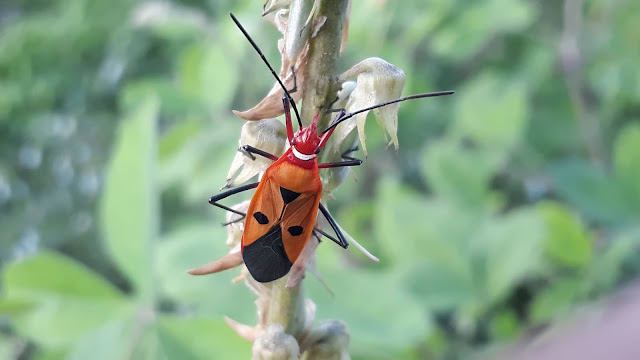Common lime Butterfly (Papilio demoleus): Scientific Classification, Habit and Habitat, Food Habit, Identifying Characters
Common lime Butterfly (Papilio
demoleus): Scientific Classification, Habit and Habitat, Food Habit, Identifying Characters
Scientific
Classification
Kingdom: Animalia
Phylum: Arthropoda
Class: Insecta
Order:
Lepidoptera
Family: Papilionidae
Genus: Papilio
Species: demoleusHabit
and Habitat:
- Papilio demoleus is a very direct and rapid-flying species of gardens, farms and sunny open areas.
- Males sometimes congregate at puddles and riverbanks in search of salts. This species avoids dense, damp forest, and excessively wet areas.
Identifying
Characters:
Adult
Male
Upperside black. Fore wing: base below cell and basal
half of latter so irrorated with yellow scales as to form more or less complete
transverse dotted lines, two outwardly oblique yellow spots in cell and a curved spot at its upper apex; a spot at the base and another beyond it in
interspace 8; a discal transverse series of cream-yellow spots irregular in
arrangement and size extends from interspace 1 a to 8 ; the series interrupted
in interspace 5 and the spot in interspace 7 double; this is followed by a
sinuous postdiscal series of spots and an admarginal terminal series of smaller
spots. In many specimens between the discal and postdiscal series the black
ground-colour is irrorated with yellowish scales.
Hind wing: base and an edging that decreases in width
along the dorsal margin irrorated with yellow scales ; followed by a broad
medial yellow irregular band, a sinuous postdiscal series of outwardly
emarginate yellow spots and a terminal series of smaller similarly coloured
spots as on the fore wing. The inner margin of the medial band is curved
inwards, the outer margin is very irregular and uneven ; in the cell the band
does not reach the apex, but beyond the cell there are one or more cream-yellow
spots, and the black ground-colour is irrorated with yellowish scales
Finally at the
tornal angle there is an oval ochraceous-red spot emarginate on its inner side
in the ♀and in both
sexes surmounted by a blue lunule ; while in interspace 7 between the medial
band and the postdiscal spot there is a large ocellus-like spot of the black
ground-colour more or less irrorated with blue scales.
Adult
Female
Underside: ground-color similar, the cream-colored
markings paler and conspicuously larger. The 'atter differ from those on the
upperside as follows: Fore wing: basal half of cell and base of wing below it
with cream-colored streaks that coalesce at base; irregular ochraceous spots
in interspaces, 5 to 8 and the discal series of spots complete not interrupted
in interspace 5.
Hind wing: the
black at the base of the wing and along the dorsal margin centered largely with pale
cream-color; the ocellus in interspace 7, the apex of the cell, and the black
ground-color between the medial band and postdiscal markings in interspaces 2-6
centered with ochraceous, margined with blue. Antennae dark reddish-brown,
touched with ochraceous on the inner side towards the club; head, thorax and
abdomen dusky black, the head and thorax anteriorly streaked with cream-yellow
; beneath the palpi, thorax, and abdomen cream-yellow with lateral
longitudinal black lines on the last.
The butterfly is tailless and has a wingspan
80–100 mm
Larva
After 1st moult tuberculate, brown with a milk-white V-shaped
mark on the 6th-9th segments, and white lateral streaks anterior and posterior
to the V-shaped markings. These make the larva look for all the world like the
droppings of some bird, and it is evidently to some extent protected thereby,
for while young, the larva feeds and rests openly on the upper side of the leaf.
Full-grown the larva is a brilliant rich green, velvety, and without tubercles, the
sides and some of the segments dorsally marked with black, yellowish-white, and
rich brown; head, legs, and prologs reddish brown.
Pupa
The pupa, which is rugose (wrinkled), stout, and 30 mm in the length has two projections to the front on its head and also one on its
thorax, and resembles that of the common Mormon (Papilio polytes), the difference being that the common Mormon pupa has a deeper cut between the
projections and its abdomen is more protruded on the sides, having a small
points. pupa is dimorphic with regards to color, with the color developing
according to the prevalent color and texture in the background. The green
morph, which is found amongst green vegetation and smoother textures, is light
green and unmarked or with yellow dorsal markings. When situated among brown or
dry objects, the pupa tend to turn light grey brown to pink brown and develop
cryptic dark brown and black striation.
References:
- https://www.cabi.org/isc/datasheet/38758
- https://archive.org/stream/butterflies02bingiala#page/60/mode/2up
- http://entnemdept.ufl.edu/creatures/bfly/lime_swallowtail.htm




Comments
Post a Comment